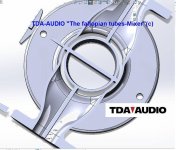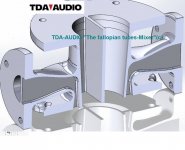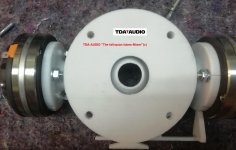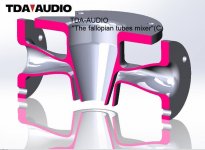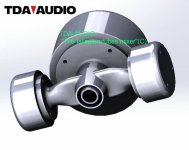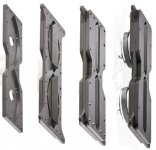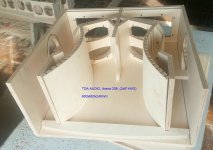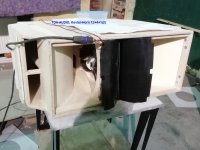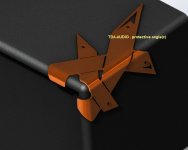Here it is.
Some of you probably knows Dima TDA Audio. It's an engineer in Russia who use to clone some of the top loudspeakers for PRO market. For years he disassembled hundreds of them, did the reverse engineering, and then began to build his own.
He got lot's measurement equipment and the small factory now.
So the guy is very experienced.
Bellow is his vision of point source.
He think that it's the midrange is critical, not the high frequency. And it should be as open/direct as possible.
He tested tens of the midrange transducers and has concluded that the 4" CD with cellulose or carbon membranes is the way to go from 500hz to 8,000hz. And only then you add tweeter or two. The port for it could be bent in some way cose it's not that critical in such high frequencies.
"It was important to get TWO-SOUND STREAM that they do not interfere with each other, phase coherent... physically time aligned drivers , fold it correctly and are equivalent it in pressure."
It's the 11-th prototype, he still working on it.
What you guys think about it?
Some of you probably knows Dima TDA Audio. It's an engineer in Russia who use to clone some of the top loudspeakers for PRO market. For years he disassembled hundreds of them, did the reverse engineering, and then began to build his own.
He got lot's measurement equipment and the small factory now.
So the guy is very experienced.
Bellow is his vision of point source.
He think that it's the midrange is critical, not the high frequency. And it should be as open/direct as possible.
He tested tens of the midrange transducers and has concluded that the 4" CD with cellulose or carbon membranes is the way to go from 500hz to 8,000hz. And only then you add tweeter or two. The port for it could be bent in some way cose it's not that critical in such high frequencies.
"It was important to get TWO-SOUND STREAM that they do not interfere with each other, phase coherent... physically time aligned drivers , fold it correctly and are equivalent it in pressure."
It's the 11-th prototype, he still working on it.
What you guys think about it?
Attachments
Last edited:
And only then you add tweeter or two. The port for it could be bent in some way cose it's not that critical in such high frequencies
Because it is high frequency, the bends become that much more catastrophic. It's why you don't see folded mid horns up past a couple 100hz. Doing it with a tweeter is just plain goofy
Because it is high frequency, the bends become that much more catastrophic. It's why you don't see folded mid horns up past a couple 100hz. Doing it with a tweeter is just plain goofy
Because it is high frequency, the bends become that much more catastrophic. It's why you don't see folded mid horns up past a couple 100hz. Doing it with a tweeter is just plain goofy[/QUOTE]
Quite opposite.
There are a lot of mid bending horns. I don't like them, TDA Audio obviously don't like them either.
Regarding High Fr. - JBL lens, split horns, bent wave guides, even Danley use the Paraline. "The result is a loudspeaker with the superior performance and pattern control of a full range horn"
Quite opposite.
There are a lot of mid bending horns. I don't like them, TDA Audio obviously don't like them either.
Regarding High Fr. - JBL lens, split horns, bent wave guides, even Danley use the Paraline. "The result is a loudspeaker with the superior performance and pattern control of a full range horn"
Attachments
Whenever possible, I try to follow two rules with waveguides:
1) Always Be Expanding. Basically I never want any segment of the waveguide to 'neck down.' The easiest way to visualize how this works is to imagine traffic on a highway; if the highway gets narrower, the traffic backs up. You don't want this in a waveguide; it creates reflections back down the throat, it creates higher order modes, it's just bad news. For instance, Smith Horns are kind of infamous for sounding awful, and I think that one of the reasons is because one of their dimensions is constant. (The top and the bottom walls are flat.) You want your waveguides to expand, all the time.
2) Trying to combine high frequency drivers is really difficult. I can't see any good reason to do it unless you need really high SPL. Even then, it's REALLY tricky.
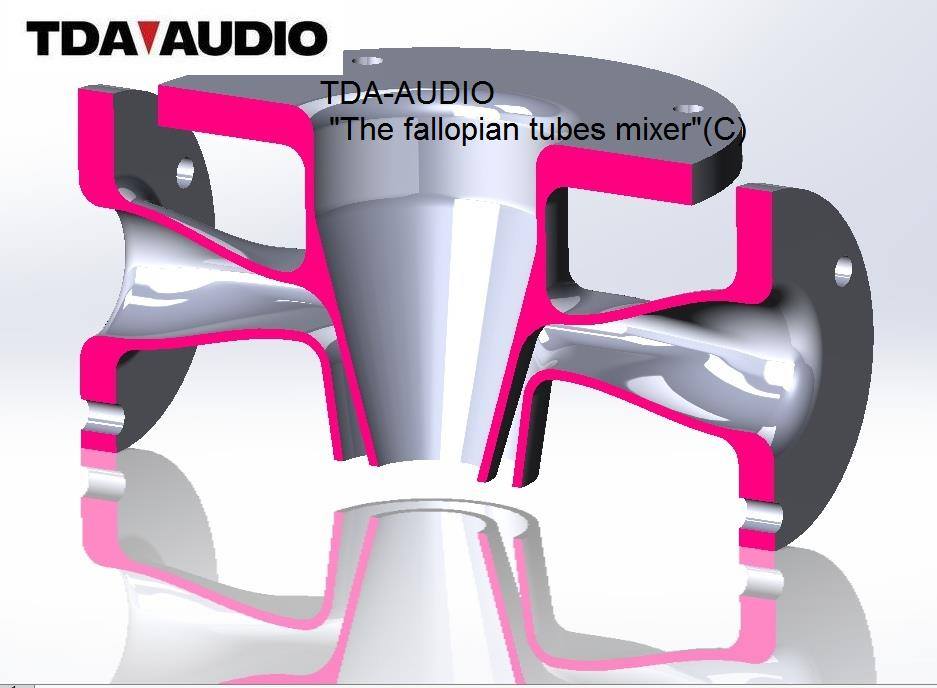
This waveguide violates both ideals
1) Always Be Expanding. Basically I never want any segment of the waveguide to 'neck down.' The easiest way to visualize how this works is to imagine traffic on a highway; if the highway gets narrower, the traffic backs up. You don't want this in a waveguide; it creates reflections back down the throat, it creates higher order modes, it's just bad news. For instance, Smith Horns are kind of infamous for sounding awful, and I think that one of the reasons is because one of their dimensions is constant. (The top and the bottom walls are flat.) You want your waveguides to expand, all the time.
2) Trying to combine high frequency drivers is really difficult. I can't see any good reason to do it unless you need really high SPL. Even then, it's REALLY tricky.
This waveguide violates both ideals
Because it is high frequency, the bends become that much more catastrophic. It's why you don't see folded mid horns up past a couple 100hz. Doing it with a tweeter is just plain goofy
Quite opposite.
There are a lot of mid bending horns. I don't like them, TDA Audio obviously don't like them either.
Regarding High Fr. - JBL lens, split horns, bent wave guides, even Danley use the Paraline. "The result is a loudspeaker with the superior performance and pattern control of a full range horn"[/QUOTE]
And one would ask why don't you like them? It's because they don't sound right at all. The paraline is a summing solution for a line array to get rid of some of the problems or rather characteristics of line arrays. It solves a "problem" and introdu es another. All other mid lenses etc are used to create a bandpass of sorts, that's all.
Should really listen to "Patrick" on this one as his own ACTUAL experiments have been documented here on diyaudio.
As an aside, let's think of 1/4 wavelength rules. How long is an actual 40hz wave? How long is a 10,000hz wave? Divide by 4...fall within that, you have summation. Miss it and then we start talking about 1/2 wavelength rules
The performance of the Danley Paraline, as shown in measurements I've seen at least, isn't exactly hi-fi. It's a brilliant idea for combining multiple HF drivers when the SPL from one just won't do and when the usual array causes weird problems (with air currents, off-firing lobes, etc). The frequency response of a Paraline isn't great, but it can get loud and is relatively consistent in coverage.
Quite opposite.
There are a lot of mid bending horns. I don't like them, TDA Audio obviously don't like them either.
Regarding High Fr. - JBL lens, split horns, bent wave guides, even Danley use the Paraline. "The result is a loudspeaker with the superior performance and pattern control of a full range horn"
And one would ask why don't you like them? It's because they don't sound right at all. The paraline is a summing solution for a line array to get rid of some of the problems or rather characteristics of line arrays. It solves a "problem" and introdu es another. All other mid lenses etc are used to create a bandpass of sorts, that's all.
Should really listen to "Patrick" on this one as his own ACTUAL experiments have been documented here on diyaudio.
As an aside, let's think of 1/4 wavelength rules. How long is an actual 40hz wave? How long is a 10,000hz wave? Divide by 4...fall within that, you have summation. Miss it and then we start talking about 1/2 wavelength rules
100% agree.
- Status
- This old topic is closed. If you want to reopen this topic, contact a moderator using the "Report Post" button.
- Home
- Loudspeakers
- Multi-Way
- Synergy. Different approach.
